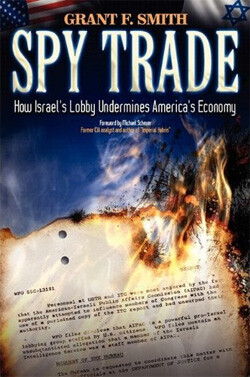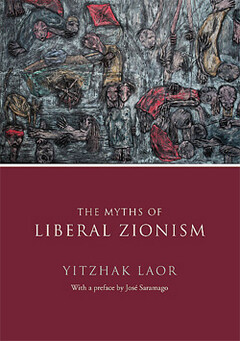The Electronic Intifada 13 December 2010

Smith argues that the lobby has systematically broken US law, damaged the country’s international reputation and generally led the country onto a path in which “irreversible damage … to US governance” is incipient (21). Smith writes that perhaps we are flirting with national “suicide.” His thesis is two-pronged. The lobby isn’t merely harming a series of American traditions and institutions. It has also become a motor of American policy-making: “The Israel lobby has become a major determinant of both US Middle East and broader economic policies,” to our collective detriment (125). The second prong of Smith’s thesis is more assertive than substantive. If there’s evidence to support the “major determinant” theory, Smith didn’t include it in his book, merely footnoting Steven Walt and John Mearsheimer’s The Israel Lobby and American Foreign Policy, which, whatever it did do, certainly did not make the case that the Israel lobby determines American macroeconomic policy.
Nevertheless, there is no question that the lobby harms the interests of ordinary Americans. Smith shows how it has broken US law, and suggests — correctly — that it should be systematically exposed and, in turn, neutered. If that was the burden of Grant’s book, he would have succeeded in proving his thesis. But he wants to show more, much more, and in the process of trying to do so, makes a series of serious missteps.
The book ranges across time and space, but a substantial portion of it is concerned with the United States-Israel Free Trade Agreement (USIFTA), signed in 1985. This justifies a corresponding focus on Smith’s analysis of USIFTA to both understand the value of what Smith has unearthed is as well as highlight the problems with his analysis.
USIFTA was the child of an agreement between then US President Ronald Reagan and Israeli Prime Minister Yitzhak Shamir to fast-track tariff-free trade relations between the Israeli and American economies. It was also understood as the implicit quo of a quid pro in which the American executive would more tightly meld the American and Israeli economies in return for Israel’s weapons-dealing to the Contras in Nicaragua. This was an institutional continuation of earlier memorandums-of-understanding through which, Smith argues, Israel had “quietly insinuated” itself into the US military-industrial complex (47). “Somewhat contrived” initially, these links nonetheless became very much real, eventually including “virtually all Israeli corporations involved in electronic warfare development,” alongside the core privatized institutions of the Israeli military-industrial complex. With the American business community tightly braided into the Israeli economy, “Israel lobby initiatives” would garner the support of the “broader American business community … as … a ‘no-brainer’ ” (49).
The US, according to Grant, received “very little in return” for these dealings, nor from taxpayer-funded “concessions” to the Israeli military-industrial complex peddled under the premise that they would help in “confronting the Soviet Union.” USIFTA followed this pattern — it was an “unprecedented gift” to Israel (50). Smith shows that “a coalition of individual experts, associations and corporations provided highly negative feedback” on the proposed USIFTA; “seventy-six were strongly opposed,” (55) including the AFL-CIO, Dow Chemical, Monsanto, the University of California and an array of smaller trade groups, corporations, alliances and institutes (129). While lobbying was ongoing, Israel was hoarding weapons and shipping them off to the US Department of Defense for reshipment on to the Contra terrorists, upping the value of its quid for the American imperium.
USIFTA passed 422-0, due to the lobby’s “influence over Congress,” taking effect on 1 September 1985. The result, Smith claims, was a serious undermining of “US economic interests” (62). The American empire got next to nothing for its barter: “Sandinista leader Daniel Ortega was never deposed by armed Contra forces.” Meanwhile, the US was “subsidizing a competing industrial complex,” while the “elite Israeli spy network … was turned fully against the US, with devastating results,” as Israel “jump-started entirely new export-oriented industries” with purloined American industrial knowledge, never punished by a corrupted and cowed Department of Justice (72).
USIFTA, meanwhile, was causing a cumulative $71 billion (inflation-adjusted) trade deficit between the US and Israel, leading to the loss of hundreds of thousands of American jobs. However, broad and systematic trade deficits between “Israel” and “America” began emerging only in 1996. Well over 95 percent of that big $71 billion cumulative deficit came only in the past 14 years. Finally, Smith notes that the USIFTA paved the way for the North American Free Trade Agreement (NAFTA). He concludes that “the core drivers of USIFTA trade policies, which sacrifice US worker income and wealth creation along with the nation’s competitiveness, have subsequently been imbedded in much larger multilateral treaties such as NAFTA” (110).
At this point, a few issues arise. First, Smith seems surprised that a free trade agreement would wound US “worker income.” Odd, because free trade agreements are built to benefit capital at the expense of workers. Second, readers should ask why he’s so swift to accept units like the “Israeli economy” and the “American economy” alongside their companion, the “American national interest.” (Anyone who wants to defend something like a coherent “national interest” can explain the common apprehensions of the Palestinian national interest shared by collaborators in Ramallah and peasants in Gaza’s borderlands.) Furthermore, interests can cross national lines. We need to look at who owns what, and national borders give us very little information about that.
Smith is not unaware of the transnational nature of the ownership structures of nominally Israeli corporations — he provides some evidence of the beginnings of the acquisition of the Israeli high-technology sector by capital from the American high-technology sector. But he should have kept digging. We also know other things: that the bulk of growth in Israeli-American “trade” since 1996 has been in the high-technology sector, and that American capital is aggressively invested in “Israeli” high-technology firms. Academics Jonathan Nitzan and Shimshon Bichler calculate that the correlation coefficient between the Tel Aviv Stock Exchange (TASE) and the NASDAQ was .7 in the five-year span from 1996 to 2001 — meaning 70 percent of variations in the TASE are “explained” by variations in the NASDAQ — as “trade” deficits begin to mount. From 2002 to 2007, a nearly synchronous 92 percent of variations in the TASE were explained by movements in the NASDAQ, as amidst a flurry of mergers and acquisitions, “Israeli” firms became decreasingly Israeli except by physical place of production. Furthermore, Israeli state subsidies to high-technology firms, as well as state-sponsored investments in human capital and infrastructure, are astronomically high. Israel is a very nice place for many American companies to invest. Smith misses an opportunity to discuss and explain the implications of this tightly-wrought economic relationship, not least of which is that the trade deficit is mostly a statistical artifact.
Nor is it appropriate to note that 76 trade organizations opposed the USIFTA and a lobby-centered clump supported it, and then infer that the Israel lobby is a “major determinant” of policy more generally. There’s no question that the lobby is the major source of atavistic support for Israel. But what do other sectors of American power want? No one has made the case to the rest of the American corporate class that supporting Israel is bad for their interests — namely their corporate bottom line. Without such a case, they largely take cues from their allies (the lobby), shrug and support Israel. Some like Mearsheimer and Chas Freeman are patiently making such a case. Others bemoan capital’s stupidity or earnestly counsel it, but it’s hopeless. There’s no reason to think capital cares about Palestinian freedom.
Forget freedom. Most sectors of American power barely care enough to dump their money into the apartheid-lite lobby, J Street, let alone to crash the hammer down on Zionist domination in the Middle East. We must be real and ask: who else is served by Israeli militarism? The lobby supports apartheid. Why does the rest of the capitalist class tolerate the lobby and its sowing of chaos? Put differently, how, for example, would arms exporters benefit from the quelling of regional tensions? How would oil majors benefit from decreased tension when their profits rise with war in the Middle East?
Unfortunately, Smith’s analytical framework has no place for such questions. Although the book represents serious and impressive research, the analysis ultimately founders on both conceptual and empirical shoals. Those interested in the history of the Israel lobby will benefit from reading Spy Trade. Those interested in an analysis that navigates around such shoals to provide satisfying explanations will need to look elsewhere.
Max Ajl is a doctoral student in development sociology at Cornell, and was an ISM volunteer in the Gaza Strip. He has written for many outlets, including the Guardian and the New Statesman, and blogs on Israel-Palestine at www.maxajl.com.
Related Links




